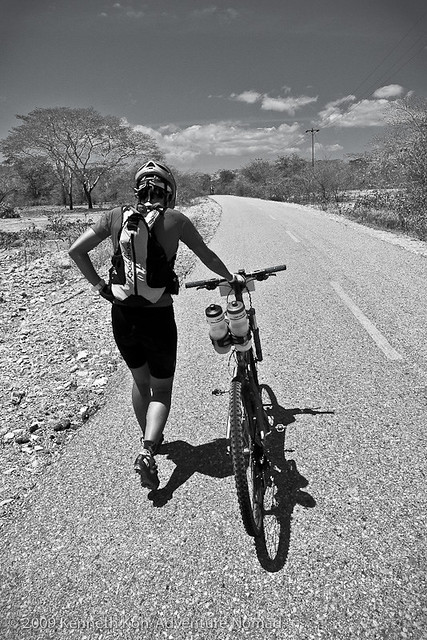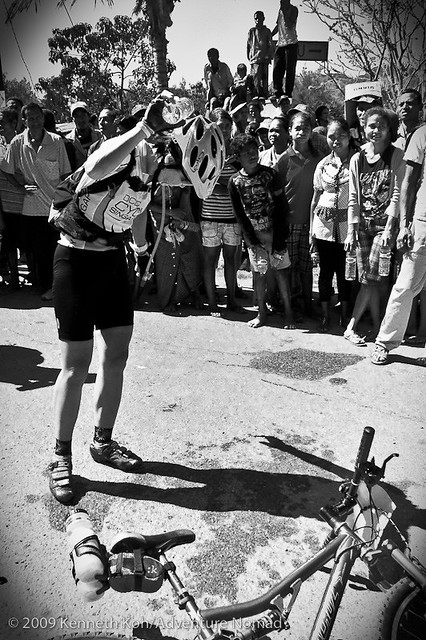Which is better for mountain biking: water bottles or a camelbak style hydration bladder pack? It's an age old debate that I'll try to answer for myself for the upcoming Cape Epic mountain bike race.
To answer the question, I need to look at how much water I'll need for the ride, and also where I'll be riding.
Quantity
Bottles are typically 750ml each, and if you can get two bottles on your frame, that will set you up with 1.5 liters (1.6 quarts). Bottles are a great option for rides or races where you can refill your bottles mid-ride. For the occasional longer ride, you could stuff another bottle in a jersey pocket and hope it doesn't fall out.
Hydration bladder packs start at 1 liter and max out at 3 liters, the size and weight of the carrier pack increases with the bladder size. A 2 liter bladder is a good choice for most situations, and 3 liters is a must for a long day out with no chance of refill. Bladders are the natural choice if you cannot refill mid-ride.
Terrain and Location
The main problem with bottles is that you need a relative straight and smooth section of trail where you can take a hand off the bars to reach down and grab a bottle for a drink. Needless to say, this takes a bit of skill, and as I learned from my recent trip to Drak Park with literally hours of continuous singletrack, it was difficult to get a drink without stopping.
The second major issue with the bottle is that all sorts of crap gets thrown up and gets around the spout of the bottle; buffalo crap, cow crap, pig crap, goat crap, chicken crap... you get the idea. The mouth piece from a hydration bladder typically sits around my shoulder, and is affected much less than the bottle on my down tube. Here in South East Asia, there are all sorts of diseases can one can pick up and that is enough reason to use a hydration bladder here.
Bottom Line
For me, I prefer to use bottles wherever possible. I think I ride faster with bottles than with a hydration backpack. I think getting as much weight off my back is also a good idea. For the Cape Epic, with aid stations 30-40km apart, I'm probably not going to get enough water just by using bottles, so I plan to use a combination of a 1.5 liter bladder (filled with Hammer Perpetuem or Endurox Accelerade
or Endurox Accelerade ) and a 750ml bottle to give me a total capacity of 2.25 liters. I hope somebody who's been there can tell me if this is a good idea.
) and a 750ml bottle to give me a total capacity of 2.25 liters. I hope somebody who's been there can tell me if this is a good idea.
 |
| Running on Empty at the Tour de Timor |
Quantity
Bottles are typically 750ml each, and if you can get two bottles on your frame, that will set you up with 1.5 liters (1.6 quarts). Bottles are a great option for rides or races where you can refill your bottles mid-ride. For the occasional longer ride, you could stuff another bottle in a jersey pocket and hope it doesn't fall out.
Hydration bladder packs start at 1 liter and max out at 3 liters, the size and weight of the carrier pack increases with the bladder size. A 2 liter bladder is a good choice for most situations, and 3 liters is a must for a long day out with no chance of refill. Bladders are the natural choice if you cannot refill mid-ride.
Terrain and Location
The main problem with bottles is that you need a relative straight and smooth section of trail where you can take a hand off the bars to reach down and grab a bottle for a drink. Needless to say, this takes a bit of skill, and as I learned from my recent trip to Drak Park with literally hours of continuous singletrack, it was difficult to get a drink without stopping.
The second major issue with the bottle is that all sorts of crap gets thrown up and gets around the spout of the bottle; buffalo crap, cow crap, pig crap, goat crap, chicken crap... you get the idea. The mouth piece from a hydration bladder typically sits around my shoulder, and is affected much less than the bottle on my down tube. Here in South East Asia, there are all sorts of diseases can one can pick up and that is enough reason to use a hydration bladder here.
 |
| Aid Station at the Tour de Timor |
For me, I prefer to use bottles wherever possible. I think I ride faster with bottles than with a hydration backpack. I think getting as much weight off my back is also a good idea. For the Cape Epic, with aid stations 30-40km apart, I'm probably not going to get enough water just by using bottles, so I plan to use a combination of a 1.5 liter bladder (filled with Hammer Perpetuem

5 comments:
That will probably work. I used a 2 liter Camelbak Rogue filled with water, and an 800 ml bottle filled with sports drink. Never ran out before reaching a water point, but then my body seems to handle heat quite well. It does get very hot over there (45C is no exception), and often there is no shade. Better not run out of water in conditions like that.
Thanks Niels, we'll consider using a 2 liter bladder as well. Do you remember about how far apart and roughly how much time between water points?
I think there were 3 water points each stage. How much time in between water points will of course depend on how fast you go ;-)
Thanks Niels. Next year, the longest stage is nearly 150km with 3000m of climbing. We'll be taking the 2 liter bladders for sure, and the biggest water bottle we can find, possibly adding an additional bottle in the jersey if we need to.
Hi Thanks for The Talking with us. it's really Helpful.
how to clean a hydration bladder
Post a Comment